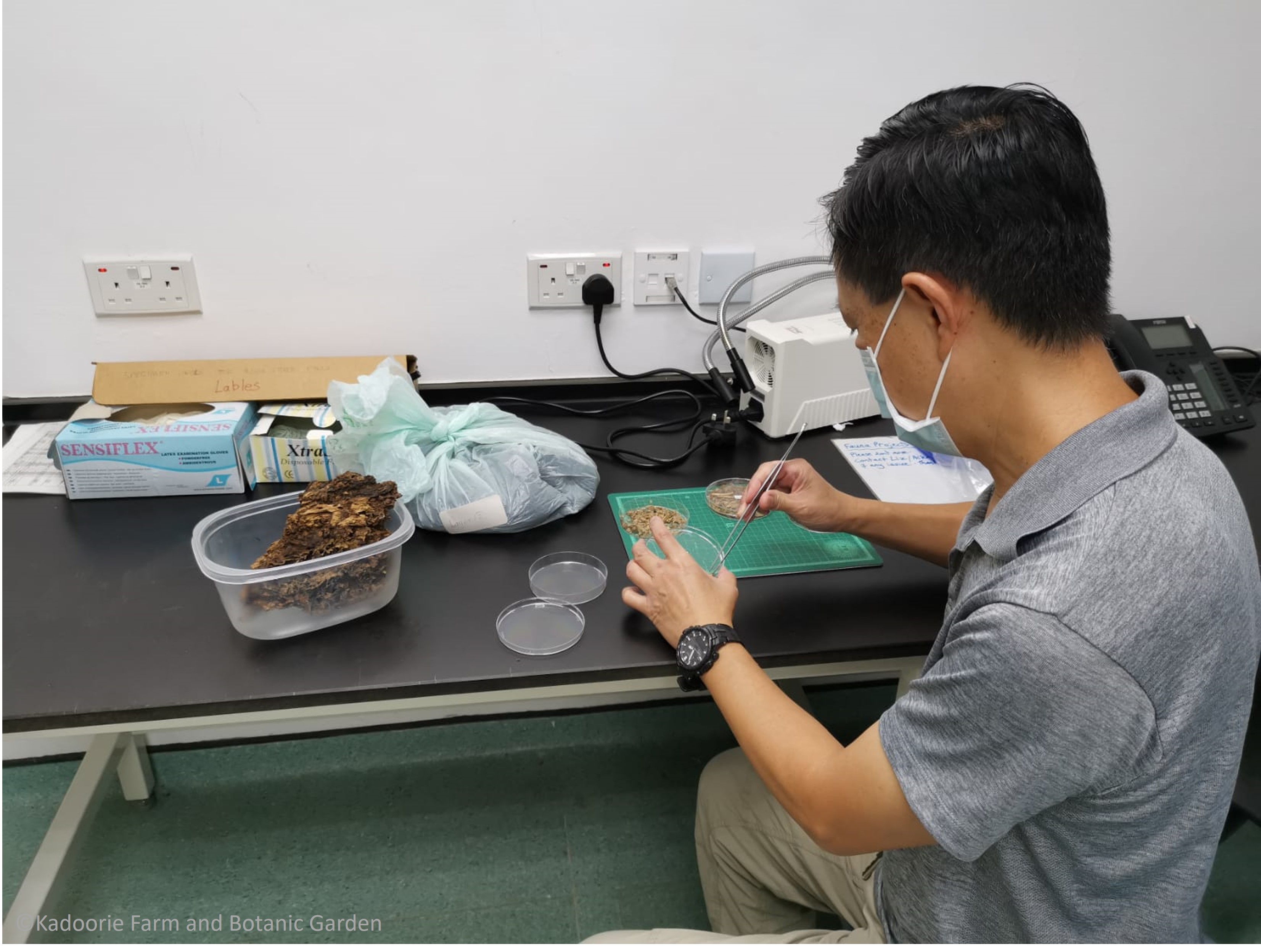What secrets can we discover at a Brown Fish Owl’s nesting site?
Hong Kong is home to several native owl species, most are nocturnal, and lead quite secretive lives. This year during the breeding season, a KFBG Board Member was very lucky to discover a pair of Brown Fish Owls (Ketupa zeylonensis) nesting and rearing young in a woodland located in New Territories.

Our volunteer Chui Kin Fai meticulously searches through the debris and food remnants removed from the abandoned nest site. (Photo Credit: KFBG / Liz Rose-Jeffreys)
During discrete observations to minimize disturbance to the family, this pair of owls reared 1 young and it fledged successfully. Since Brown Fish Owls are quite scarce in Hong Kong, and although it is commonly known that they are fish hunters, not much information is available regarding foraging behaviour. Also feeding observations are rare and there have been few reports of pellets being discovered and dissected to determine food habits for the species. After the juvenile owl fledged, the parents left the nest and did not return to the tree. This allowed an opportunity to search the nesting area and the ground below for pellet and prey fragments. It appears that this species is remarkably tidy with no discarded remains being found below the tree. Some collection was made from the exact location where the young owl spent most of its time while developing. The collected material seemed to consist of small wood and bark fragments, so initially there was low expectation of discovering any information regarding the food of the nestling.
Fortunately, a sharp-eyed volunteer Chui Kin Fai who was tasked with the analysis of the woody nest material was able to discover an interesting collection of animal remains.

Food remnants teased out of the woody material found at the nest site. Mammal (rodent) bones at the top, mammal and fish bones middle and fish scales in the petri dish. (Photo Credit: KFBG / Aiko Leong)
The volunteer worked patiently for several hours searching through 3 separate layers of woody material discovered at the nest site. We not only found a number of fish scales and bones, but also, small mammal bones and eggshell pieces. This reflected a fairly consistent food choice by the parents.
We were unable to determine if the fish scales were a marine or freshwater species, but the mammal bones resembled those of a rodent and the eggshell could have been the remains of the owl’s eggs.

The Brown Fish Owl nestling with well-developed feathers shortly before it left the tree nest in the New Territories. (Photo Credit: KFBG Board Member)
Observations of food remains at unoccupied nests can help us to gain some insight into the dietary choice of the parent birds when feeding their nestlings. According to a study, of 192 feeding activities recorded by night vision cameras of a nesting pair of Brown Fish Owls in India, the pair offered 60% invertebrate, that is insects, shrimps and crabs, 25% amphibian, 23% reptiles and small number of fish and birds to their young. It is interesting that no characteristic remains of crabs or shrimps were discovered in our study and we wonder whether these prey items were not available near the nesting area thus, parent birds tend to offer other abundant prey, which may indicate Brown Fish Owl has high plasticity in feeding preference. The project demonstrates that it can be interesting discovering what was not eaten or provided to the nestling as identifying what was provided.

The juvenile owl after becoming more mobile and exploring the branches close to the nest. (Photo Credit: KFBG Board Member)
We hope that we may have further opportunity to analyse more material from the Brown Fish Owl in future to make a comparison with what we discovered during the 2021 nesting season.
By Aiko Leong
Reference
Vyas, R., Upadhayay, K., Patel, M. R., Bhatt, R. D., & Patel, P., 2013. Notes on the breeding of the Brown Fish Owl Ketupa zeylonensis. Indian BIRDS 8 (6): 147–151.

